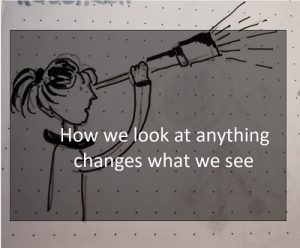How you look at something affects your experience of it, for better or for worse

There’s always another way of looking at something. It doesn’t matter what it is, there’s always another way, whether more useful or less useful, or equally useful. How you look at something affects your experience of it, for better or for worse. So it’s to your benefit to look at things in a way that enables you to have a good experience rather than a bad one.
I use the word ‘looking’ to mean not just ‘seeing’ with your physical eyes or all your physical senses but also to thinking and especially to feeling. If you want to change your experience of say, a pain that you’re experiencing in your stomach, not only do you have to change how you think about it, you need to change how you feel about it.
Now, you’re probably thinking, I might be able to change how I think about something but I don’t think I can control how I feel about it.
I used to absolutely loathe and dread snakes. The very thought of it would send shivers down my spine and I’d quickly think of something else. If I saw anything that even remotely reminded me of a snake, I’d have a similar reaction. This has occasionally hampered my ability to fully enjoy things such as bush walking. When I realized how debilitating my relationship with snakes or the image of snakes was, I decided I had to do something about it. I began by first changing my thinking.

I began to deliberately think about how the snake is no different to any other animal including the human. It wants to be safe and unthreatened. Its defensive behaviours of attack happen when it feels its safety is threatened. I also began to ask what it was that made me so afraid of snakes. I realized that there were a number of reasons. One of them was hearing stories of people who’d been bitten and poisoned by snakes, some fatally. Another was witnessing other people’s terrified reactions to snakes.
I also realized that the thing that really put me on edge about them was what I perceived as the unpredictability of their movement. Their eyes don’t give away much and because they glide or slither and can do so with enormous speed while also raising parts their body, I felt that I could not possibly anticipate which direction they’d be going and how. I would always assume that they’d want to go for me and bite me in places I could not possibly avoid.
Once I understood the sources of my fear, I began to gently persuade myself to see things differently. Once again, comparing them to other animals and our common need to feel safe was helpful. But what helped solidify i.e. internalize this for me was actually making myself look at images of snakes and watch videos of them moving. It also helped to watch videos and sometime live instances of people handling snakes in a friendly and harmonious way.
What this did was change the emotional response I had thus far toward snakes. The thinking itself helped to soften my resistance toward them so that I was no longer convinced that I had to be terrified of them and that there was a different way of seeing them. This prepared the ground for an emotional shift such that I actually began to feel less afraid (not just think that I needn’t be afraid) and, wait for this, more empathetic towards them.
I remember how this new relationship first expressed itself when, one summer’s day, my cat, Basil, who’d himself never encountered a snake before, found a little tree snake in our porch. He expressed great curiosity in it and, anxious that it didn’t get out of his reach as it moved, used his paw to keep it in place. When I saw this, my immediate response was to protect the snake – something I would never have considered doing in the past. I didn’t think that my cat would deliberately hurt the snake, he had never expressed any such tendency toward any animal, but I was afraid he might do so accidentally.
Now, did my desire to protect the snake mean I had no fear of it? No, by default, I assume all snakes are deadly and that old thinking was still active. So, yes, I was afraid that if things went wrong, both my cat and I might be at the sorry end of this affair. But, at least as strong as my fear of being bitten or poisoned (this despite knowing that tree snakes are not poisonous), was my desire to keep the snake safe.
I got a bucket, and waited for a chance to get it in full view and close range which I did, once I got Basil out of the way. I then placed the bucket over it and while my heart was still racing, called the council to get advice on what I might do next. Being a Saturday, there was no one to take my call. Fortunately, I was expecting a couple of clients who arrived soon enough. They happily took the snake and set it free in the bush a few hundred metres from my house.
I have had a similar change of heart towards other animals that I’ve dreaded such as spiders and flies. Changing my thinking was important. It is, what you might say, a necessary step. But it is not sufficient. Changing our attitude (how we thing and feel) is required.
So, yes, we can certainly change how we not only think about something or someone but also how we feel toward them. When we get the feeling part happening, then we can be sure that the change is complete. I have done this with respect to many people that I’ve felt antagonism and even hatred toward including people that I may not know personally such as Tony Abbott as well as those I’ve lived with and experienced first-hand such as my father, someone who actually did cause me great physical and emotional pain.
You know, in the end, what really determines whether you make the change is whether you want it enough. And wanting is very much an emotional thing. Without the emotional fuel, no intention will have the momentum needed to cross the line from old to new, from past to future, from undesirable to desirable, from worse to better.
REFLECTION
What is something or someone you have an aversion to? When did you first feel this way towards them? How does feeling this way help you? For example, Does it help you protect yourself? Does it make you feel superior and boost your confidence?
CALL TO ACTION
Make a list of all the ways in which you feel you benefit from feeling this way. Then make a second list of all the benefits you would have if you didn’t feel this way. Find one benefit from the first list that you could replace with a benefit from the second list. Take some form of action to express this.
HEALING STATEMENT
MENTORING Let Life express itself intoxicatingly, uniquely, powerfully and limitlessly in, as and through you. Don’t settle, whatever your age. Know your true Self. Follow your Bliss. Live the Life that you know you want to! Contact me here.It is never about whether I can. It is always about whether I am willing. I give myself permission to see differently.
MINDFULNESS ONLINE Join me every week to sit in the presence of your true Self and experience the greatness of Life flowing naturally, effortlessly and powerfully in, as and through you!